Effects of Cropland Expansion on the Regional Land Surface Radiative Energy Balance and Heat Fluxes in Northern China
Abstract
1. Introduction
2. Materials and Methods
2.1. Study Area
2.2. Data Sources
2.2.1. Land Use Data
2.2.2. Remote Sensing Products
2.2.3. Radiation Data
2.3. Methodology
2.3.1. Data Preprocessing
2.3.2. Calculation of Radiative Forcing and the Heat Flux to the Atmosphere Due to Cropland Expansion
3. Results
3.1. Spatial Pattern of Cropland Expansion
3.2. Effects of Cropland Expansion on Surface Parameters
3.3. Impact of Cropland Expansion on Surface Radiative Forcing
3.4. Effects of Cropland Expansion on Heat Flux from the Land Surface to the Atmosphere
4. Discussion
4.1. Effect of Other Factors on Surface Radiative Energy Balance
4.2. Limitations and Prospects
5. Conclusions
Funding
Institutional Review Board Statement
Informed Consent Statement
Data Availability Statement
Acknowledgments
Conflicts of Interest
References
- Song, X.-P.; Hansen, M.C.; Stehman, S.V.; Potapov, P.V.; Alexandra, T.; Vermote, E.F.; Townshend, J.R. Global land change from 1982 to 2016. Nature 2018, 560, 639–643. [Google Scholar] [CrossRef]
- Rigden, A.J.; Li, D. Attribution of surface temperature anomalies induced by land use and land cover changes. Geophys. Res. Lett. 2017, 44. [Google Scholar] [CrossRef]
- Pan, Y.D.; Birdsey, R.A.; Fang, J.Y.; Houghton, R.; Kauppi, P.E.; Kurz, W.A.; Phillips, O.L.; Shvidenko, A.; Lewis, S.L.; Canadell, J.G.; et al. A large and persistent carbon sink in the world’s forests. Science 2011, 333, 988–993. [Google Scholar] [CrossRef]
- Popkin, G. How much can forests fight climate change? Nature 2019, 565, 280–282. [Google Scholar] [CrossRef]
- Huang, L.; Zhai, J.; Ning, J. Impacts of returning farmland to forest on regional air temperature in different climatic zones. J. Nat. Resour. 2017, 32, 1832–1843. [Google Scholar]
- Rotenberg, E.; Yakir, D. Contribution of semi–arid forests to the climate system. Science 2010, 327, 451–454. [Google Scholar] [CrossRef] [PubMed]
- Lee, X.; Goulden, M.L.; Hollinger, D.Y.; Barr, A.; Black, T.A.; Bohrer, G.; Bracho, R.; Drake, B.; Goldstein, A.; Gu, L.H.; et al. Observed increase in local cooling effect of deforestation at higher latitudes. Nature 2011, 479, 384–387. [Google Scholar] [CrossRef] [PubMed]
- Huang, L.; Zhai, J.; Liu, J.; Sun, C. The moderating or amplifying biophysical effects of afforestation on CO2-induced cooling depend on the local background climate regimes in China. Agric. Meteorol. 2018, 260, 193–203. [Google Scholar] [CrossRef]
- Arora, V.K.; Montenegro, A. Small temperature benefits provided by realistic afforestation efforts. Nat. Geosci. 2011, 4, 514–518. [Google Scholar] [CrossRef]
- Bastin, J.F.; Finegold, Y.; Garcia, C.; Mollicone, D.; Rezende, M.; Routh, D.; Zohner, C.M.; Crowther, T.W. The global tree restoration potential. Science 2019, 365, 76–79. [Google Scholar] [CrossRef]
- Shindell, D.T.; Faluvegi, G.; Rotstayn, L.; Milly, G. Spatial patterns of radiative forcing and surface temperature response. J. Geophys. Res. Atmos. 2015, 120, 5385–5403. [Google Scholar] [CrossRef]
- Anderson–Teixeira, K.J.; Snyder, P.K.; DeLucia, E.H. Do biofuels life cycle analyses accurately quantify the climate impacts of biofuels–Related land use change? Univ. Ill. Law Rev. 2011, 10, 589–622. [Google Scholar]
- Solomon, S.D.; Qin, D.; Manning, M.; Chen, Z.; Miller, H.L. Climate Change 2007: The Physical Science Basis: Working Group I Contribution to the Fourth Assessment Report of the IPCC; Cambridge University Press: Cambridge, UK, 2007. [Google Scholar]
- Liu, C.; Allan, R.P.; Mayer, M.; Hyder, P.; Loeb, N.G.; Roberts, C.D.; Valdivieso, M.; Edwards, J.M.; Vidale, P.L. Evaluation of satellite and reanalysisbased global net surface energy fluxand uncertainty estimates. J. Geophys. Res. Atmos. 2017, 122, 6250–6272. [Google Scholar] [CrossRef] [PubMed]
- Davin, E.L.; de Noblet-Ducoudre, N. Climatic impact of global–Scale deforestation: Radiative versus non radiative processes. J. Clim. 2010, 23, 97–112. [Google Scholar] [CrossRef]
- Luyssaert, S.; Jammet, M.; Stoy, P.C.; Estel, S.; Pongratz, J.; Ceschia, E.; Churkina, G.; Don, A.; Erb, K.; Ferlicoq, M.; et al. Land management and land–cover change have impacts of similar magnitude on surface temperature. Nat. Clim. Chang. 2014, 4, 389–393. [Google Scholar] [CrossRef]
- McAlpine, C.A.; Syktus, J.; Deo, R.C.; Lawrence, P.J.; McGowan, H.A.; Watterson, I.G.; Phinn, S.R. Modeling the impact of historical land cover change on Australia’s regional climate. Geophys. Res. Lett. 2007, 34, 393–418. [Google Scholar] [CrossRef]
- Liu, F.S.; Tao, F.L.; Xiao, D.P.; Zhang, S.; Wang, M.; Zhang, H. Influence of land use change on surface energy balance and climate: Results from SiB2 model simulation. Prog. Geogr. 2014, 33, 815–824. [Google Scholar]
- Zhang, X.Z.; Wang, W.C.; Fang, X.Q.; Ye, Y.; Zheng, J.Y. Agriculture development-induced surface albedo changes and climate implications across northeastern China. Chin. Geogr. Sci. 2012, 22, 264–277. [Google Scholar] [CrossRef]
- Ge, Q.S.; Zheng, J.Y.; Zhang, X.Z.; He, F.N. Simulated effects of cropland expansion on summer climate in eastern China in the last three centuries. Adv. Meteorol. 2013, 63, 93–100. [Google Scholar] [CrossRef]
- Yu, L.X.; Zhang, S.W.; Tang, J.M.; Liu, T.X.; Bu, K.; Yan, F.Q.; Yang, C.B.; Yang, J.C. The effect of deforestation on the regional temperature in northeastern China. Appl. Clim. 2015, 120, 761–771. [Google Scholar] [CrossRef]
- Liang, S. Recent developments in estimating land surface biogeophysical variables from optical remote sensing. Prog. Phys. Geog. 2007, 31, 501–516. [Google Scholar] [CrossRef]
- White, J.C.; Wulder, M.A.; Hermosilla, T.; Coops, N.C. Satellite time series can guide forest restoration. Nature 2019, 569, 630. [Google Scholar] [CrossRef]
- Zhao, M.; Running, S.W. Drought-induced reduction in global terrestrial net primary production from 2000 through 2009. Science 2010, 329, 940–943. [Google Scholar] [CrossRef] [PubMed]
- Ren, M.E.; Bao, H.S. Physical geographical regionalization of China. In China Natural Geographic Atlas; Sino Maps Press: Beijing, China, 1998. [Google Scholar]
- Liu, J.Y.; Kuang, W.H.; Zhang, Z.X.; Xu, X.L.; Qin, Y.W.; Ning, J.; Zhou, W.C.; Zhang, S.W.; Li, R.D.; Yan, C.Z.; et al. Spatiotemporal characteristics, patterns, and causes of land–use changes in China since the late 1980s. J. Geogr. Sci. 2014, 24, 195–210. [Google Scholar] [CrossRef]
- Ning, J.; Liu, J.Y.; Kuang, W.H.; Xu, X.L.; Zhang, S.W.; Yan, C.Z.; Li, R.D.; Wu, S.X.; Hu, Y.F.; Du, G.M.; et al. Spatiotemporal patterns and characteristics of land-use change in China during 2010–2015. J. Geogr. Sci. 2018, 28, 547–562. [Google Scholar] [CrossRef]
- Sumner, D.M.; Wu, Q.L.; Pathak, C.S. Variability of albedo and utility of the MODIS albedo product in forested wetlands. Wetlands 2011, 31, 229–237. [Google Scholar] [CrossRef]
- Planque, C.; Carrer, D.; Roujean, J.L. Analysis of MODIS albedo changes over steady woody covers in France during the period of 2001–2013. Remote Sens. Environ. 2017, 191, 13–29. [Google Scholar] [CrossRef]
- Wan, Z.; Zhang, Y.; Zhang, Q. Quality assessment and validation of the MODIS global land surface temperature. Int. J. Remote Sens. 2004, 25, 261–274. [Google Scholar] [CrossRef]
- Mu, Q.Z.; Zhao, M.S.; Running, S.W. Improvements to a MODIS global terrestrial evapotranspiration algorithm. Remote Sens. Environ. 2011, 115, 1781–1800. [Google Scholar] [CrossRef]
- He, T.; Shao, Q.Q. Spatial-temporal variation of terrestrial evapotranspiration in China from 2001 to 2010 using MOD16 products. J. Geo–Inf. Sci. 2014, 16, 979–988. [Google Scholar]
- Hall, D.K.; Riggs, G.A. Accuracy assessment of the MODIS snow products. Hydrol. Process. 2007, 21, 1534–1547. [Google Scholar] [CrossRef]
- Pu, Z.X.; Xu, L.; Salomonson, V.V. MODIS/Terra observed seasonal variations of snow cover over the Tibetan Plateau. Geophys. Res. Lett. 2007, 34, 137–161. [Google Scholar] [CrossRef]
- Dee, D.P.; Uppala, S.M.; Simmons, A.J.; Berrisford, P.; Poli, P.; Kobayashi, S.; Andrae, U.; Balmaseda, M.A.; Balsamo, G.; Bauer, P.; et al. The ERA-Interim reanalysis: Configuration and performance of the data assimilation system. Q. J. R. Meteor. Soc. 2011, 137, 553–597. [Google Scholar] [CrossRef]
- Liang, S.L.; Shuey, C.J.; Russ, A.L. Narrowband to broadband conversions of land surface albedo: II. Validation. Remote Sens. Environ. 2003, 84, 25–41. [Google Scholar] [CrossRef]
- Román, M.O.; Schaaf, C.B.; Lewis, P. Assessing the coupling between surface albedo derived from MODIS and the fraction of diffuse skylight over spatially-characterized landscapes. Remote Sens. Environ. 2010, 114, 738–760. [Google Scholar] [CrossRef]
- Huang, L.; Zhai, J.; Sun, C.Y.; Liu, J.Y.; Ning, J.; Zhao, G.S. Biogeophysical forcing of land use changes on local temperatures across different climate regimes in china. J. Clim. 2018, 31, 7053–7068. [Google Scholar] [CrossRef]
- Thandlam, V.; Rahaman, H. Evaluation of surface shortwave and longwave downwelling radiations over the global tropical oceans. SN Appl. Sci. 2019, 1, 1171. [Google Scholar] [CrossRef]
- Flanner, M.G.; Shell, K.M.; Barlage, M.; Perovich, D.K.; Tschudi, M.A. Radiative forcing and albedo feedback from the Northern Hemisphere cryosphere between 1979 and 2008. Nat. Geosci. 2011, 4, 151–155. [Google Scholar] [CrossRef]
- Meister, W.N.; Gao, H.L. Assessing the impacts of vegetation heterogeneity on energy fluxes and snowmelt in boreal forests. J. Plant Ecol. 2011, 4, 37–47. [Google Scholar] [CrossRef]
- Diffenbaugh, N.S. Influence of modern land cover on the climate of the United States. Clim. Dynam. 2009, 33, 945–958. [Google Scholar] [CrossRef]
- Shi, W.J.; Tao, F.L.; Liu, J.Y. Regional temperature change over the Huang-Huai-Hai Plain: The roles of irrigation versus urbanization. Int. J. Climatol. 2014, 34, 1181–1195. [Google Scholar] [CrossRef]
- Doelman, J.C.; Stehfest, E.; Vuuren, D.P.V.; Tabeau, A.; Hof, A.F.; Braakhekke, M.C.; Gernaat, D.E.H.J.; Berg, M.; Zeist, W.J.; Daioglou, V.; et al. Afforestation for climate change mitigation: Potentials, risks and trade-offs. Glob. Chang. Biol. 2020, 26, 1576–1591. [Google Scholar] [CrossRef]
- Douglas, E.M.; Beltran-Przekurat, A.; Niyogi, D.; Pielke, R.A.; Vorosmarty, C.J. The impact of agricultural intensification and irrigation on land-atmosphere interactions and Indian monsoon precipitation—A mesoscale modeling perspective. Glob. Planet. Chang. 2009, 67, 117–128. [Google Scholar] [CrossRef]
- Mao, D.L.; Cai, F.Y.; Zhao, F.; Lei, J.Q.; Lai, F.B.; Xue, J. Spatial difference of microclimate in shelterbelts in newly reclaimed land in Jiya Township in Hotan, Xinjiang. Arid Zone Res. 2018, 35, 821–829. [Google Scholar]
- Lee, X. Forests and climate: A warming paradox. Science 2010, 328, 1479. [Google Scholar] [CrossRef] [PubMed]
- Swann, A.L.; Fung, I.Y.; Levis, S.; Bonan, G.B.; Doney, S.C. Changes in arctic vegetation amplify high-latitude warming through the greenhouse effect. Proc. Natl. Acad. Sci. USA 2010, 107, 1295–1300. [Google Scholar] [CrossRef] [PubMed]

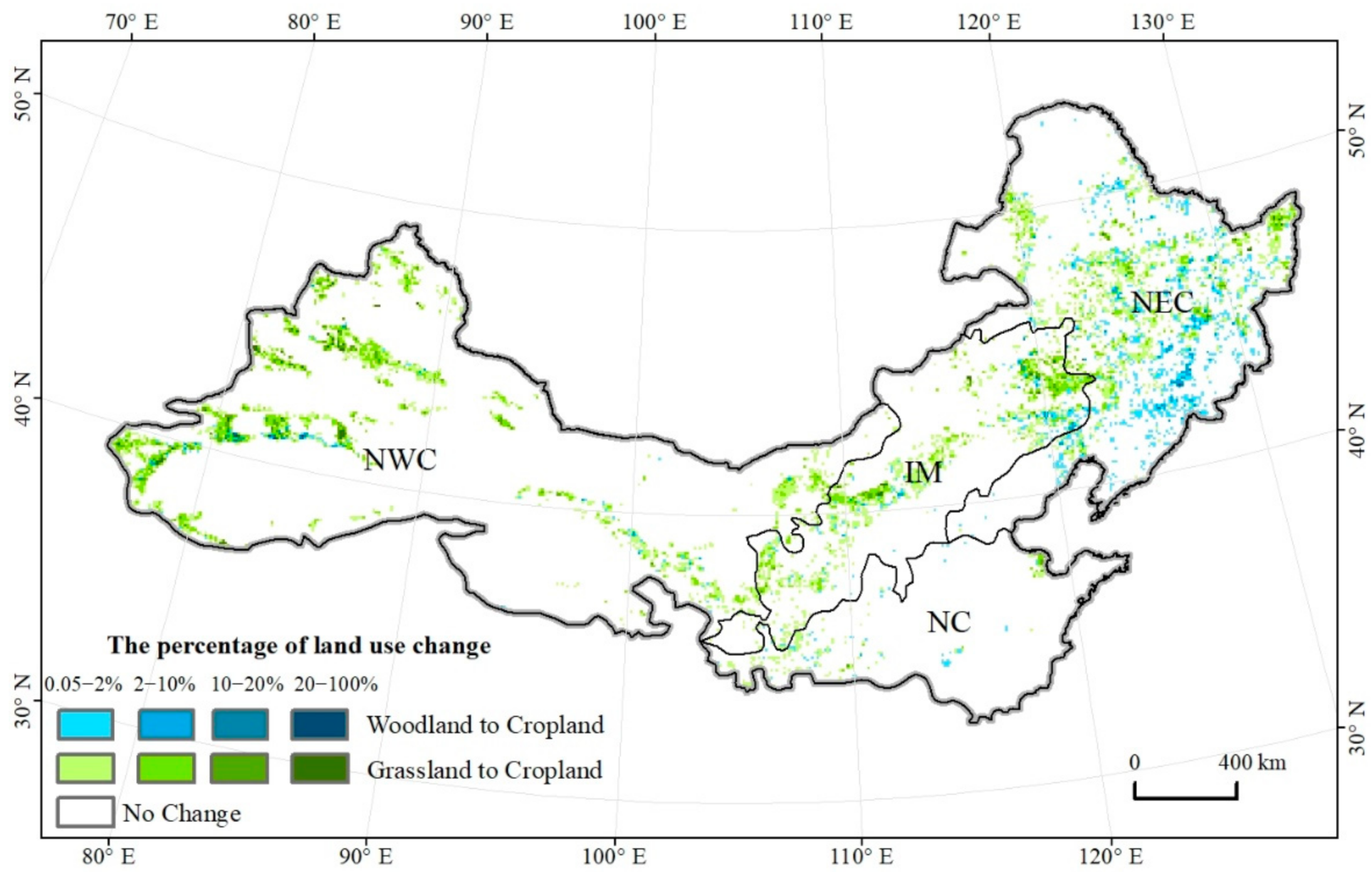

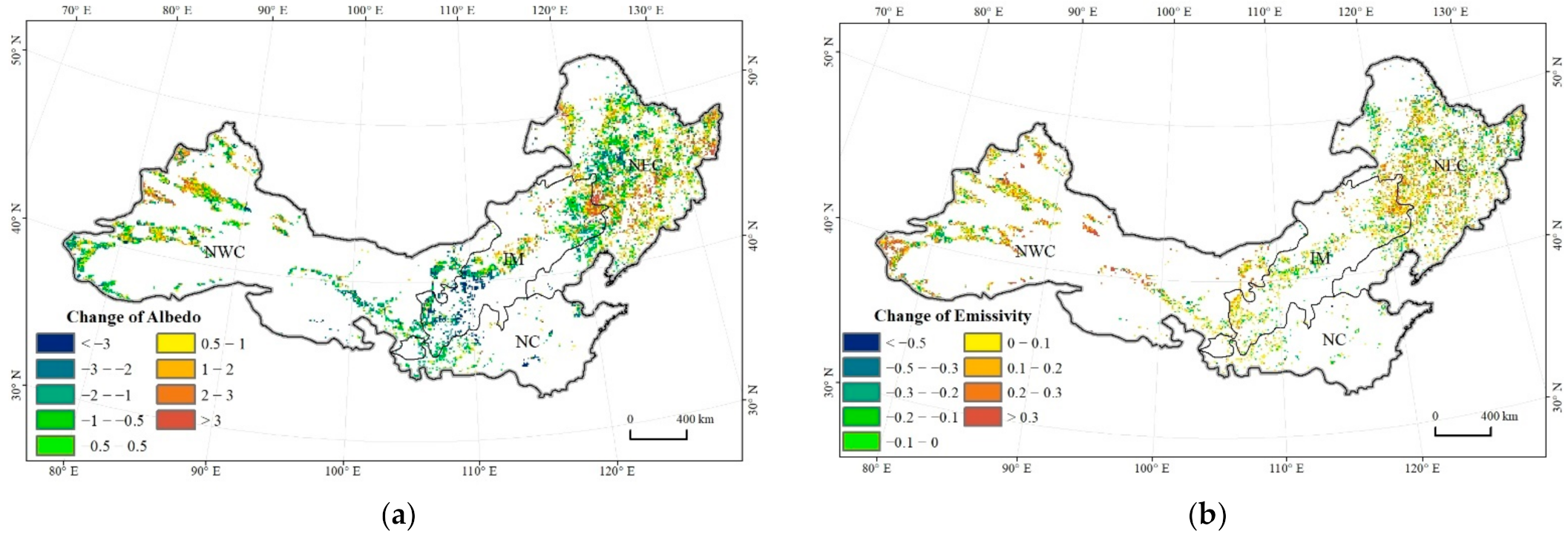
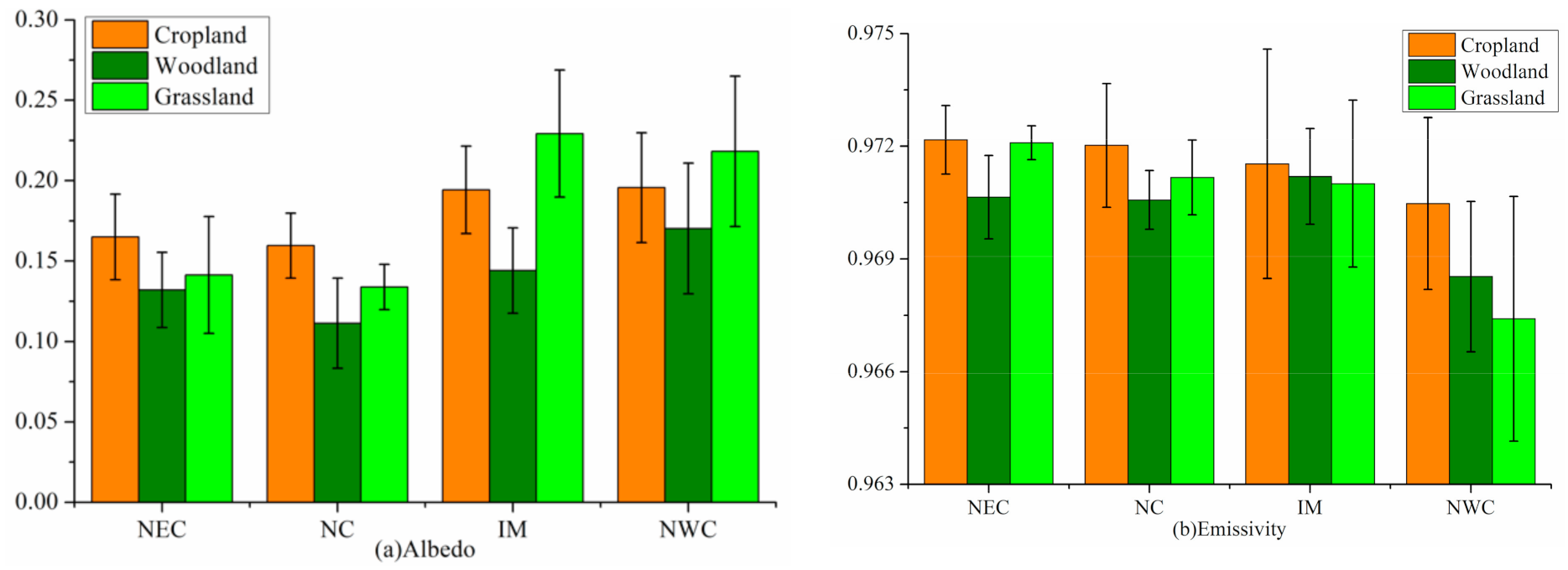
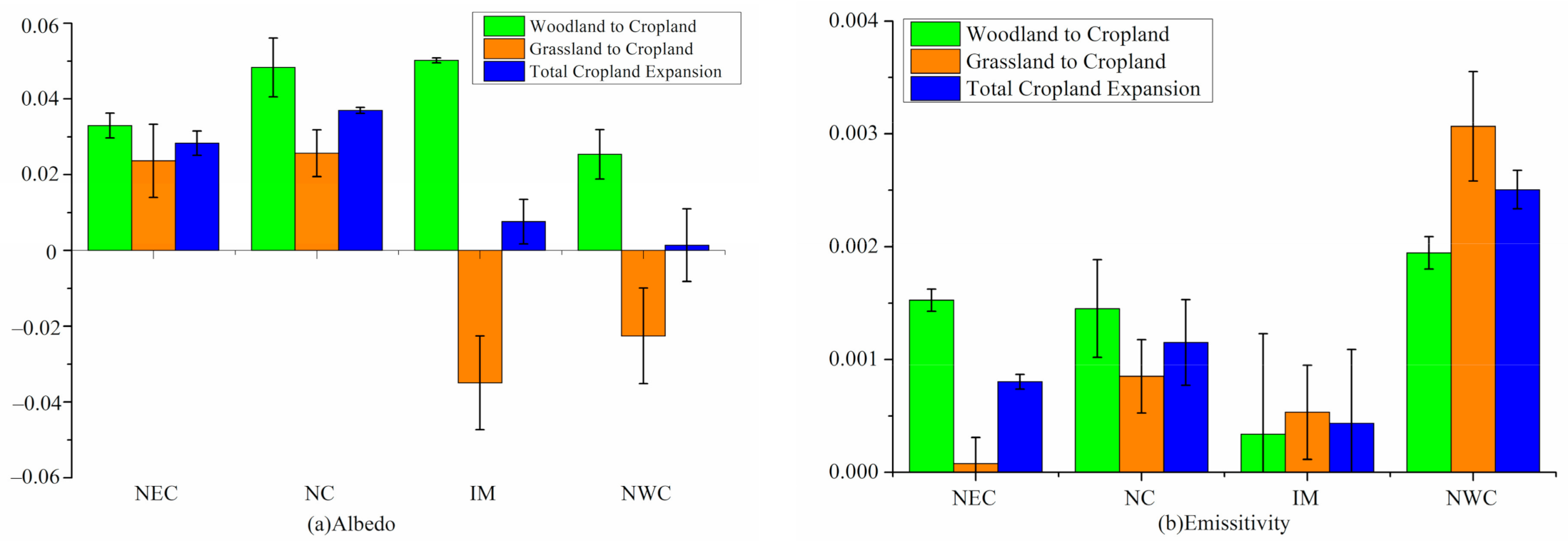

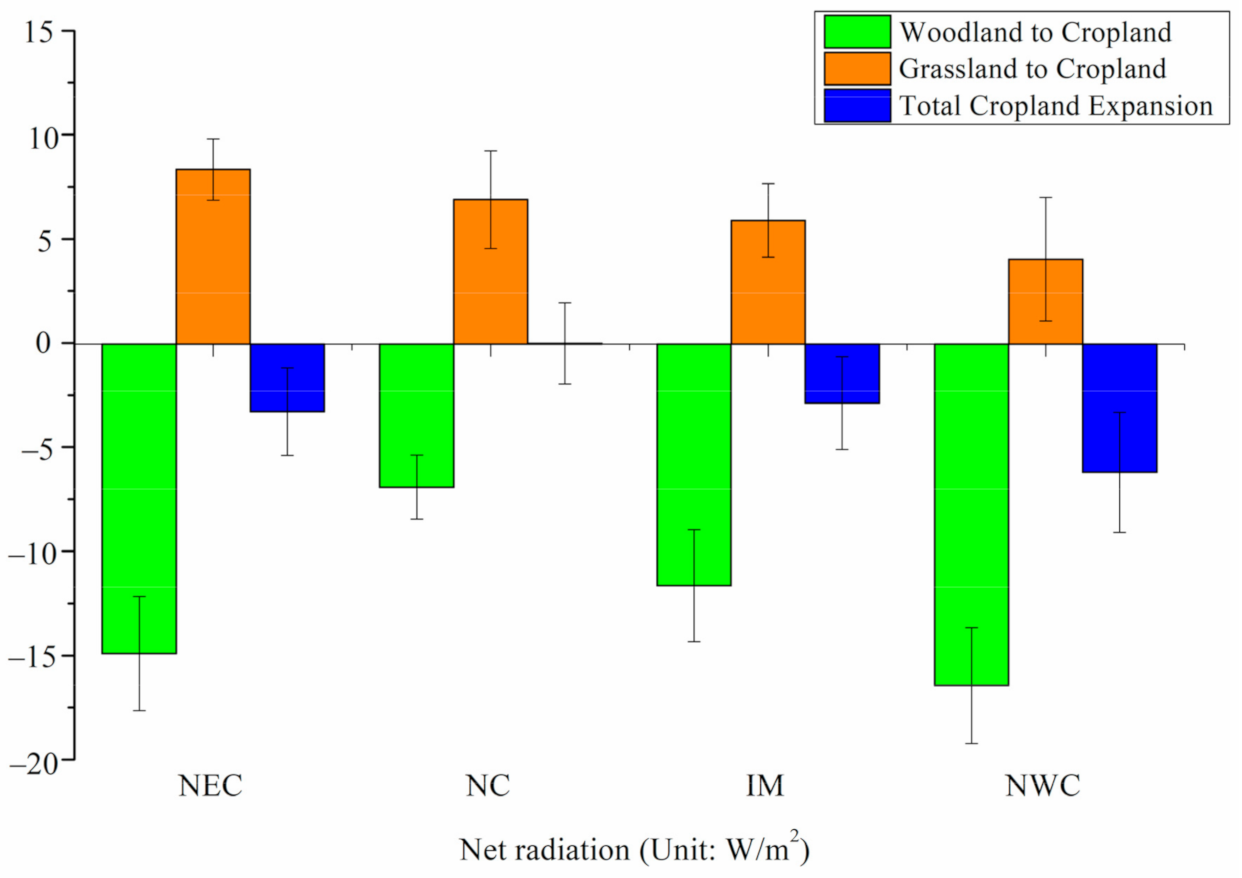
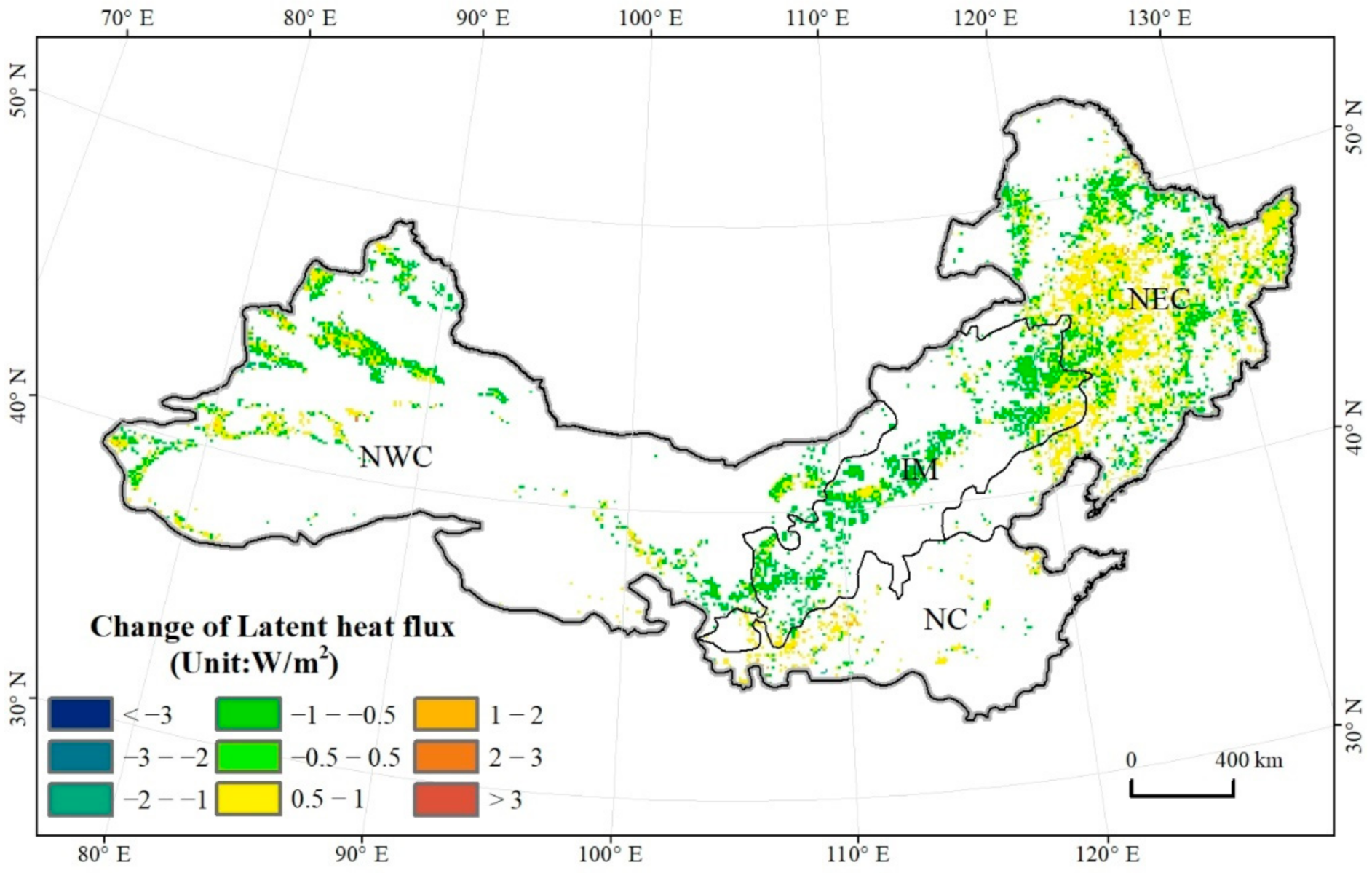
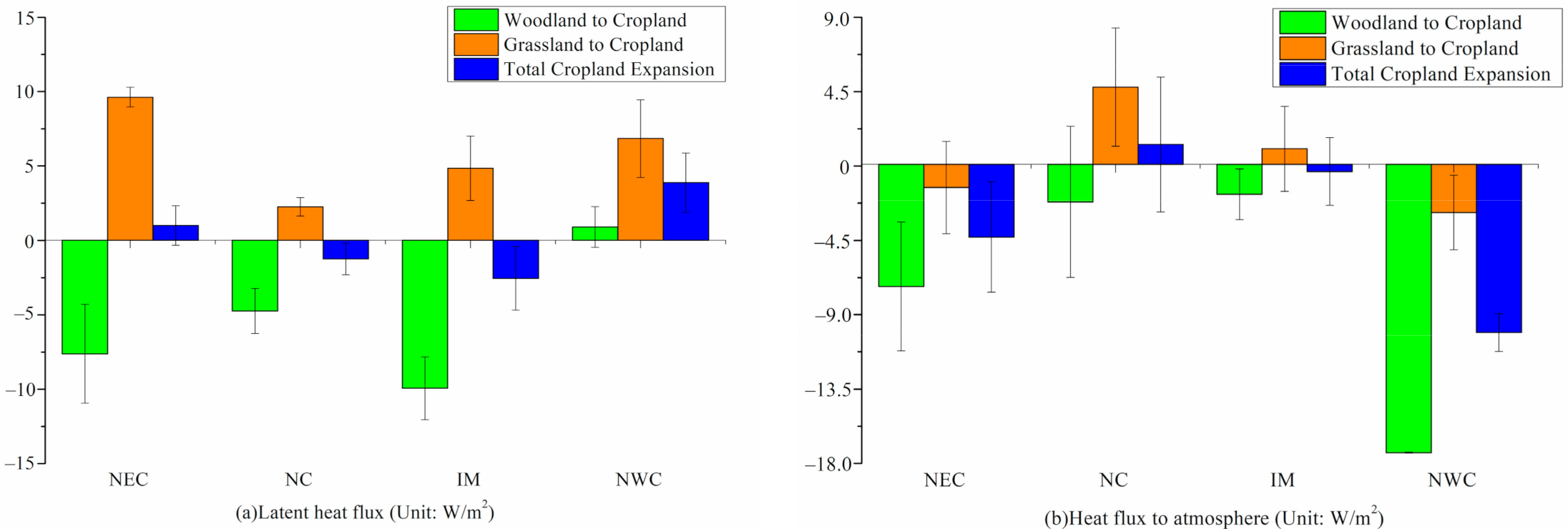
| Zone Name | ≥10 °C Accumulated Temperature (°C) | Drought Index | Frost-Free Season (Day) |
|---|---|---|---|
| NEC | 1400–3200 | 0.5–1.2 | <145 |
| IM | 2000–3000 | 1.2–4.0 | <180 |
| NWC | 3200–4500 | >4.0 | <200 |
| NC | 3200–4500 | 0.5–1.5 | 150–200 1 |
| Data | Data Source | MAE 1 | Spatial Resolution | Temporal Resolution |
|---|---|---|---|---|
| Land use | Land-use database from CAS | ≥90% 2 | 1 km | - |
| Albedo | MCD43B3 | −0.008 | 1 km | 8 d |
| Emissivity | MOD11A2 | 0.001–0.005 | 1 km | 8 d |
| LST | MOD11A2 | ≤1 °C | 1 km | 8 d |
| Latent heat flux | MOD16A2 | 0.31 to 0.33 mm.d−1 | 1 km | 8 d |
| Snow | MOD10A2 | ≥93% 3 | 500 m | 8 d |
| Radiation data | ERA-Interim | - | 0.75° | Monthly |
Publisher’s Note: MDPI stays neutral with regard to jurisdictional claims in published maps and institutional affiliations. |
© 2021 by the author. Licensee MDPI, Basel, Switzerland. This article is an open access article distributed under the terms and conditions of the Creative Commons Attribution (CC BY) license (http://creativecommons.org/licenses/by/4.0/).
Share and Cite
Ning, J. Effects of Cropland Expansion on the Regional Land Surface Radiative Energy Balance and Heat Fluxes in Northern China. Appl. Sci. 2021, 11, 1556. https://doi.org/10.3390/app11041556
Ning J. Effects of Cropland Expansion on the Regional Land Surface Radiative Energy Balance and Heat Fluxes in Northern China. Applied Sciences. 2021; 11(4):1556. https://doi.org/10.3390/app11041556
Chicago/Turabian StyleNing, Jia. 2021. "Effects of Cropland Expansion on the Regional Land Surface Radiative Energy Balance and Heat Fluxes in Northern China" Applied Sciences 11, no. 4: 1556. https://doi.org/10.3390/app11041556
APA StyleNing, J. (2021). Effects of Cropland Expansion on the Regional Land Surface Radiative Energy Balance and Heat Fluxes in Northern China. Applied Sciences, 11(4), 1556. https://doi.org/10.3390/app11041556






